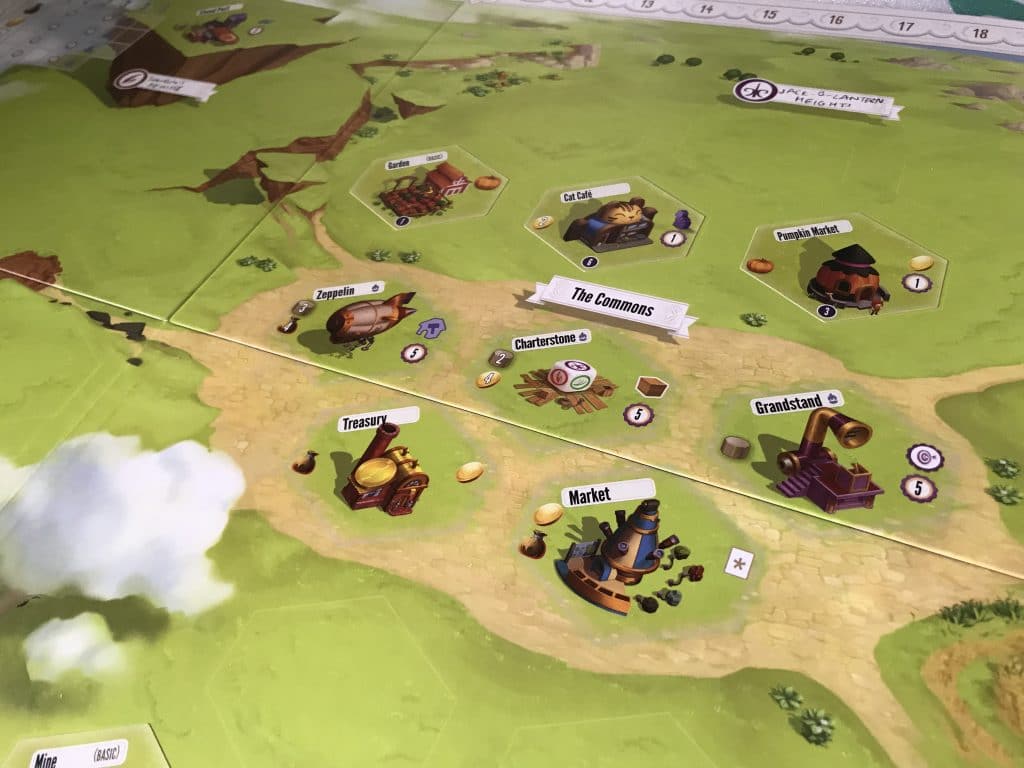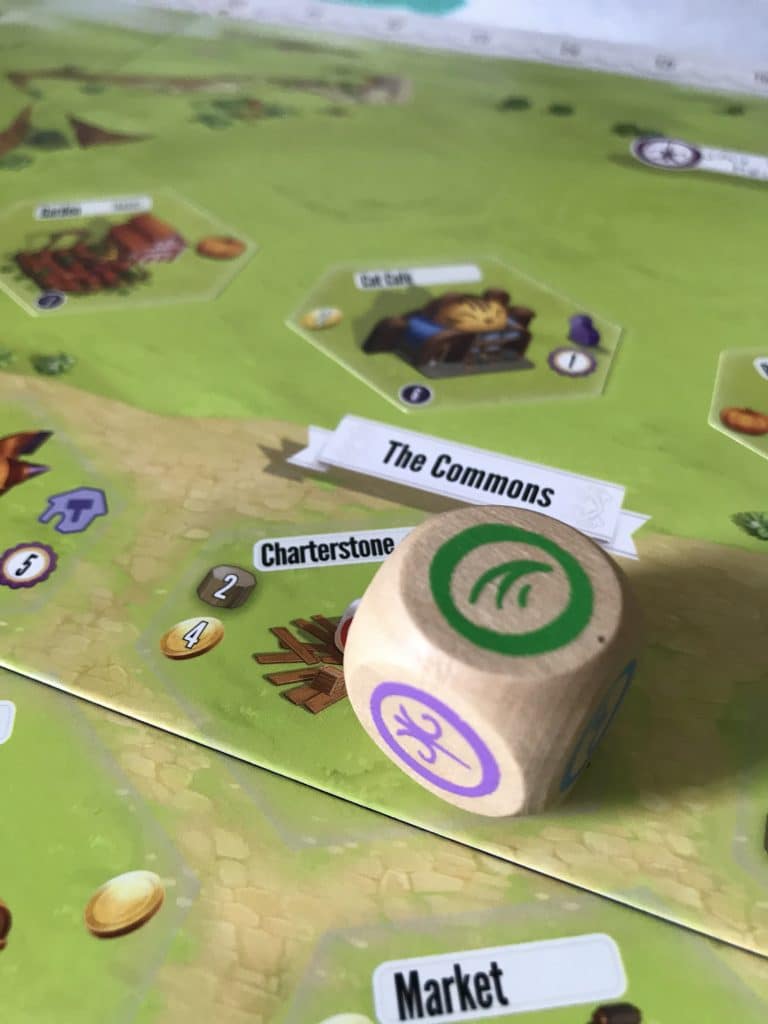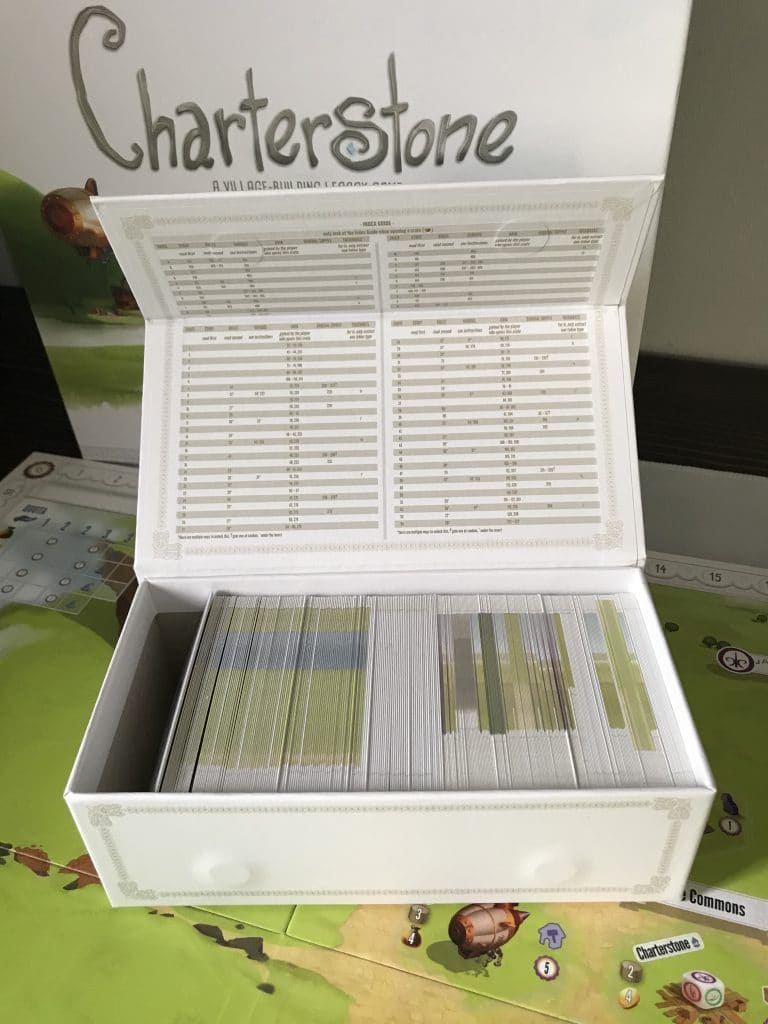Here at Nerds on Earth, we talk ad nauseam about how many board games come out each year, and how it’s absolutely impossible to keep up with the releases. Even if I played every game once, and never took a break to eat or sleep, I wouldn’t be able to play every game over the course of a year.
And then, I’d have a backlog PLUS the next years’ releases!
Charterstone, by Stonemaier Games, is one of those games that I missed out on when it was first released. Now it’s poised for a reprint, so I finally got a chance to play through several rounds to get a feel for the game. There may be mild spoilers below, but I’ll try to keep them to a minimum.
Continue reading for a glimpse into my thoughts on Charterstone!

Charterstone: A Little Slice of Heaven
At first blush, Charterstone doesn’t necessarily fit the description of a game that I’m immediately drawn towards. The artwork has a cartoony quality that isn’t my forte, but it definitely emphasizes the carefree nature of the game.
In Charterstone, players assumed the roles of various characters tasked with populating and improving their own section of land. Each player gets put in charge of a charter, and together those charters are being assessed by the Forever King, a mysterious benefactor and ruler of this realm.
What makes Charterstone unique is the presentation. The rulebook is filled with blank spaces, which you will fill in with stickers as you progress through the game. To take that a step further, most of the game’s possibilities are locked and concealed until you discover them through play.
It’s actually daunting how few rules there are to start out. The game walks you through the rules of setup and within a handful of minutes you’re ready to play. Players write on cards to name characters, put physical stickers on the game board, and progress by constructing buildings, opening crates, and hiring assistants.
This is worth noting: Charterstone is a legacy game. From round to round, players will keep resources and cards that they’ve acquired in previous rounds, and the gamestate stays the same. In this way, the replayability goes way down after you play through the 12-game campaign. Luckily, if you ever want to start over, you can pick up the Charterstone Recharge Pack to try and unlock aspects of the game you may have missed.
For some, this might be a turn-off, and understandably so. However, there is still ample opportunity to play rounds of the game with your finalized board, or you can play in charters that you didn’t use in previous games.
As with most legacy games, a lot of the fun comes from the secrecy and discovery of new game mechanics. Therefore, I will try my best to refrain from substantial spoilers over the course of my review.
Staking Our C.L.A.I.M on Charterstone
 Components
Components
I’ve really only played one other legacy board game besides Charterstone, and that was another Stonemaier title: The Rise of Fenris. Therefore, I have a limited range of comparison points for similar multi-session games.
I loved the presentation of the components in Charterstone. You open the box and what do you find? More boxes! Everything is tucked away in special boxes, waiting for you to unlock and discover it in-game.
The interesting part of this game is that the board changes as you build structures. You actually press permanent stickers onto the board to facilitate this, enabling the legacy facet of the game. After all, it doesn’t make much sense to try and remember where all the pieces go between games.
Everything is presented in a high-quality fashion, which is what we’ve come to expect from Stonemaier. There are plenty of nice wooden components, which I personally prefer to plastic.
My only component qualm is that the stickers can be difficult to peel off without bending the card. Thanks to my Magic: the Gathering background, I abhor the bending of any cards, even ones that don’t matter. There’s something off-putting about that crackly, white crease that doesn’t sit well with me. In that sense, I wish the stickers came off the card more easily, but it’s a minor quibble.
 Luck
Luck

As a legacy game, Charterstone doesn’t have players being adversely affected by luck mechanics. There is a special die, but it doesn’t come into play relatively often other than the beginning of games.
Instead, Charterstone is a worker-placement game that puts value to resource relationships. Players will need to plan ahead to gather the necessary materials to build structures and take actions at the different locations.
With each subsequent game, it seems like the game gets more complex. My experience was mainly two-player, which limits the sprawl of the board. I can see the complexity vastly increase with a full table. In fact, it could be a turn-off to people who prefer less-complex games, as it can be a lot to manage in your head.
 Aesthetics
Aesthetics
I mentioned this above, but the cartoonish art style of Charterstone isn’t necessarily my jam. That being said, the art is cohesive and works really well for the game. It’s meant to be a fun, lighthearted approach to building up a civilization on a deserted island.
Since a lot of information is contained within hexagonal stickers, some of the iconography can be a bit small. If you’re playing with a full table, this can be an issue when trying to read everything from across the table. As the charters are filled in, this amplifies the problem.
The ambiguity of the true intentions of the Forever King, the quirky crates, and the whimsical steampunk atmosphere had me excited to keep unlocking more of the game to see what treasures were hidden within. It’s a beautiful game with a stunning box art. Seriously, look at that box!
 Interest
Interest
So who would like Charterstone? BoardGameGeek ranks Charterstone at a 2.81 complexity at the time of this review, slightly weighing the game towards the heavier end of the scale. In my opinion, the art style and presentation can somewhat mask the weightiness of the game.
The more people you add to the game, the more brain-busting you’ll have to do. Now, if you’re just playing this with two people, the complexity drops quite a bit. It also helps to build and learn from the first round of the game, as the rules only expand from there. The first round provides a good foundation without overwhelming players.
Overall, the worker-placement aspect of the game is easy to understand. It’s really the logical piece of plotting out future moves that can trip up some players. As a comparison-point, I would actually disagree with BGG and say that Viticulture is an easier worker-placement game if you’re playing Charterstone with 3+ players.
 Mood
Mood

Progressing through the game and unlocking mechanics is such a joy. Every time you open a crate to get more cards, you’ll feel that excitement of discovery and mystery. And, I will point out, there’s a LOT to discover! It’s also interesting to see the thematic avenues that each charter seems to specialize in over time. Even so, there’s a lot of choice available for players to customize their charter with the given options.
The point of the game is to build up a presence on this island, and you really get that feeling as a player. As much as some people might detest placing permanent stickers on the board, it gives a sense of personalization that makes your game unlike any other. Additionally, you’re giving names to people and places in the game, furthering this idea.
Without spoiling anything, the Forever King also instills emotions based on what happens during the game. Always keep the King in the back of your mind, because those eyes are always watching!
Charterstone: A Charter Flight to Fun
Like I said, Charterstone stands out as a game unlike any other that I’ve played to this point. And, with the latest reprint, I’m happy that other people will get to share in this same sense of wonder.
I’m definitely awarding Charterstone with the Nerds on Earth Seal of Awesomeness. After more than five rounds of play, I was still excited to see how the charters would progress. There’s enough variability in each game to keep things fresh, which is greatly appreciated.
If the stickers are a major sticking point with you, or if you want to give Charterstone a whirl before digging into a physical copy, you can always check out the digital app. Recently released, Acram Digital made a comprehensive app that does a really good job of presenting the game as intended. You can find it on most platforms, including iOS and Steam.
Grab the crowbar, open those crates, and experience a wonderful legacy game experience with Charterstone!
You can get the Charterstone board game here, direct via Stonemaier Games, or, better yet, ask for it at your Friendly Local Game Shop (FLGS).
[Disclosure: Nerds on Earth purchased a discounted copy of Charterstone from Stonemaier Games in exchange for an honest review.]

